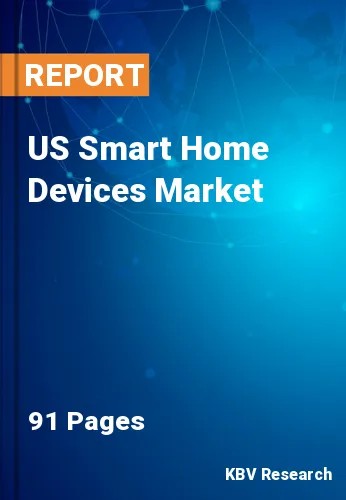Chapter 1. Market Scope & Methodology
1.1 Market Definition
1.2 Objectives
1.3 Market Scope
1.4 Segmentation
1.4.1 US Smart Home Devices Market, by Component
1.4.2 US Smart Home Devices Market, by Type
1.5 Methodology for the research
Chapter 2. Market Overview
2.1 Introduction
2.1.1 Overview
2.1.1.1 Market Composition and Scenario
2.2 Key Factors Impacting the Market
2.2.1 Market Drivers
2.2.2 Market Restraints
2.2.3 Market Opportunities
2.2.4 Market Challenges
2.2.5 Market Trends
Chapter 3. Competition Analysis - Global
3.1 KBV Cardinal Matrix
3.2 Recent Industry Wide Strategic Developments
3.2.1 Partnerships, Collaborations and Agreements
3.2.2 Product Launches and Product Expansions
3.2.3 Acquisition and Mergers
3.3 Top Winning Strategies
3.3.1 Key Leading Strategies: Percentage Distribution (2019-2023)
3.3.2 Key Strategic Move: (Partnership & Collaboration: 2019, Dec – 2024, Feb) Leading Players
3.4 Porter Five Forces Analysis
Chapter 4. US Smart Home Devices Market
4.1 US Smart Home Devices Market, by Component
4.2 US Smart Home Devices Market, by Type
Chapter 5. Company Profiles – Global Leaders
5.1 Johnson Controls International PLC
5.1.1 Company Overview
5.1.2 Financial Analysis
5.1.3 Segmental & Regional Analysis
5.1.4 Research & Development Expenses
5.1.5 Recent strategies and developments:
5.1.5.1 Partnerships, Collaborations, and Agreements:
5.1.5.2 Acquisition and Mergers:
5.1.6 SWOT Analysis
5.2 Schneider Electric SE
5.2.1 Company Overview
5.2.2 Financial Analysis
5.2.3 Segmental and Regional Analysis
5.2.4 Research & Development Expense
5.2.5 Recent strategies and developments:
5.2.5.1 Partnerships, Collaborations, and Agreements:
5.2.5.2 Product Launches and Product Expansions:
5.2.5.3 Acquisition and Mergers:
5.2.5.4 Geographical Expansions:
5.2.6 SWOT Analysis
5.3 Siemens AG
5.3.1 Company Overview
5.3.2 Financial Analysis
5.3.3 Segmental and Regional Analysis
5.3.4 Research & Development Expense
5.3.5 Recent strategies and developments:
5.3.5.1 Partnerships, Collaborations, and Agreements:
5.3.5.2 Acquisition and Mergers:
5.3.6 SWOT Analysis
5.4 Honeywell International, Inc.
5.4.1 Company Overview
5.4.2 Financial Analysis
5.4.3 Segmental and Regional Analysis
5.4.4 Research & Development Expenses
5.4.5 Recent strategies and developments:
5.4.5.1 Partnerships, Collaborations, and Agreements:
5.4.5.2 Acquisition and Mergers:
5.4.6 SWOT Analysis
5.5 Amazon.com, Inc.
5.5.1 Company Overview
5.5.2 Financial Analysis
5.5.3 Segmental Analysis
5.5.4 Recent strategies and developments:
5.5.4.1 Partnerships, Collaborations, and Agreements:
5.5.5 SWOT Analysis
5.6 Apple, Inc.
5.6.1 Company Overview
5.6.2 Financial Analysis
5.6.3 Regional Analysis
5.6.4 Research & Development Expense
5.6.5 SWOT Analysis
5.7 Google LLC (Alphabet Inc.)
5.7.1 Company Overview
5.7.2 Financial Analysis
5.7.3 Segmental and Regional Analysis
5.7.4 Research & Development Expense
5.7.5 Recent strategies and developments:
5.7.5.1 Partnerships, Collaborations, and Agreements:
5.7.6 SWOT Analysis
5.8 Robert Bosch GmbH
5.8.1 Company Overview
5.8.2 Financial Analysis
5.8.3 Segmental and Regional Analysis
5.8.4 Research & Development Expense
5.8.5 SWOT Analysis
5.9 Raytheon Technologies Corporation
5.9.1 Company Overview
5.9.2 Financial Analysis
5.9.3 Segmental and Regional Analysis
5.9.4 Research & Development Expense
5.9.5 SWOT Analysis
5.10. Samsung Electronics Co., Ltd. (Samsung Group)
5.10.1 Company Overview
5.10.2 Financial Analysis
5.10.3 Segmental and Regional Analysis
5.10.4 SWOT Analysis

